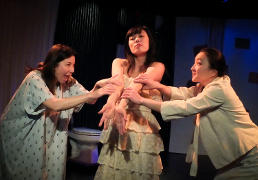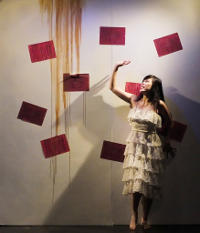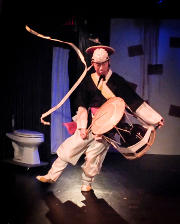
Kelly Aliano
|
A Haunting in the Lower East Side "Big Flower Eater"
Walking out of “Big Flower Eater,” conceived and directed by Victoria Linchong, and currently playing at Theater for the New City, I could not help but wonder how I would feel if my grandmother decided to haunt in me in my bathroom, of all places. This situation, the central plotline of the play, questions how one might react if her familial, ancestral, and religious past came back to contact her. Most significantly, this play explores the idea of the “other”: the other world, the Asian other in American, the other woman who never married or had children, and so on. Despite how thought-provoking and important this thematic work is, a thin story often prevents the key ideas behind this play from fully getting off the ground. Although there are some truly winning moments in this production, not enough richness is unearthed from the play’s subject matter to truly touch the soul.
This play centers on a haunting in a thirty-something’s bathroom; we are first introduced to the ghost of a Chinese grandmother, bemoaning the destruction of her fortunes upon the bathroom wall and still searching for a husband lost in the Second World War. As the play progresses, we also meet both her granddaughter—somewhat lost in the pressures of womanhood in our modern world—and her granddaughter’s friend, a Korean woman who may have deep connections with the realm of the dead. A subplot about another ghost, who appears to be a young woman stranded in a hospital gown in search of a lost “jacket,” is also presented. Each of these threads of story is so underdeveloped, however, that despite any interest one might have in the play’s action, it is extremely difficult to fully engage with what is happening on stage. Scenes are short and do not give sufficient time for character development, depth, or even differentiation. The same three actresses play all of the roles in the play, as well as provide the voice of the chorus, and it is often difficult to tell their various identities apart. In addition, the story is consistently interrupted with sequences that occur out-of-time with the rest of the play. These episodes break the proverbial fourth wall, containing movement work, which is an interesting idea, though not specific enough to be particularly compelling. Despite the flawed physical work, these scenes often contain the play’s most interesting content: narrative speeches describing the development of Asian religions, spirituality, role of women, and the like. I found the monologues presented in these interludes to be the most compelling text within the play. Additionally, for me, the discussion of Korean religion—punctuated with an up-tempo “praise” song—was a highlight of the production.
The other highlight was the percussionist, Vongku Pak; the production is worth seeing for his instrumental and dance work alone. He is also delightful in a small role as the principle female character’s father. The drumming punctuates the abstract sequences and adds extra dimension to an otherwise one-note production. The choice, at times, to portray the ghostly figures as blurry projections—broadcast on flimsy white sheets—is an ingenious one, but it is not consistent enough for me to celebrate its execution. Sometimes the ghosts are on screen, sometimes they can pass through to the corporeal world, and although a series of vertically hung strings suggests the veil between these realities, it is not entirely clear why these entities exist on one plane and not the other at any given moment. Overall, I enjoyed thinking more deeply about the presence of spirituality and spirits in our often all-too-tangible contemporary American world. I applaud the amount of research that went in to this production and, having seen “Big Flower Eater,” feel that I have some new knowledge about the role of shamanism in certain Asian cultures. What the play lacks in finesse, it more than makes up for in passion for its source material. But perhaps it needs to spend a little more time developing its own spirit—the central narrative theme for this story—in order to ensure that its ideas haunt its audiences for many years to come. |
| museums | NYTW mail | recordings | coupons | publications | classified |



